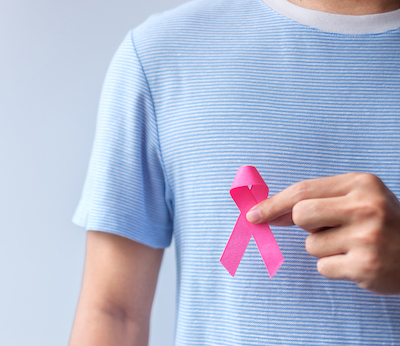Early Detection and Education of Breast Cancer in Men Is Essential
September 25, 2023
 While breast cancer is more common and heard of in women, men can also be diagnosed with breast cancer. In 2023, an estimated 297,790 women will be diagnosed with breast cancer, compared to 2,800 men.* The Centers for Disease Control and Prevention reports that men may experience poorer outcomes than women, and more than 500 men die from breast cancer every year. Education and awareness of breast cancer in men is important.
While breast cancer is more common and heard of in women, men can also be diagnosed with breast cancer. In 2023, an estimated 297,790 women will be diagnosed with breast cancer, compared to 2,800 men.* The Centers for Disease Control and Prevention reports that men may experience poorer outcomes than women, and more than 500 men die from breast cancer every year. Education and awareness of breast cancer in men is important.
Although men often experience lumps that can be felt, they are less likely to assume the lump is breast cancer. Men may also ignore symptoms due to perceived stigmas and fear of emasculation, according to a 2018 study published in the American Journal of Men’s Health. This has led to male breast cancer usually being detected only after a hard lump has already developed. A male can screen himself, and if there is any concern of a lump his physician may suggest a mammogram.
“Early detection of breast cancer among both men and women increases treatment options and can reduce the risk of dying from breast cancer,” says Jill Enter, MD, FACS, a general surgeon with Aiken Regional Medical Centers and Aiken Physicians Alliance.
Symptoms and Risk Factors
Common symptoms of breast cancer in both men and women include a lump or swelling in the breast, redness or flaky skin, irritation or dimpling in the breast area, nipple discharge, nipple turned inward or pain in the nipple area. Breast cancer risks in men can include advanced age, family history and genetic mutations, endocrine therapy treatment, certain conditions that affect the testicles, liver disease and obesity, according to the CDC.
Diagnosis and Treatment
As with women, a diagnostic mammogram can help to detect breast cancer in men. “The precise imaging of 3D mammography is very useful in improving breast cancer detection for both men and women,” says Dr. Enter.
The most common type of breast cancer found in both men and women is invasive ductal carcinoma. This occurs when the cancer cells begin in the ducts and then grow outside and into other parts of the breast tissue.
Breast cancer treatment in both men and women depends on how big the tumor is and how far it has spread and may include surgery, chemotherapy, radiation therapy, hormone therapy and targeted therapy. However, more research is needed on the best treatment approaches for men. A 2023 study, published in the Journal of the National Cancer Institute, found that unlike breast cancer in women, survival rates for men’s breast cancer have not significantly improved in the last 30 years.**
To find out if you are due for your annual mammogram, schedule an appointment with your primary care physician.
Sources:
*Breast Cancer Research Foundation
**The Journal of the National Cancer Institute
